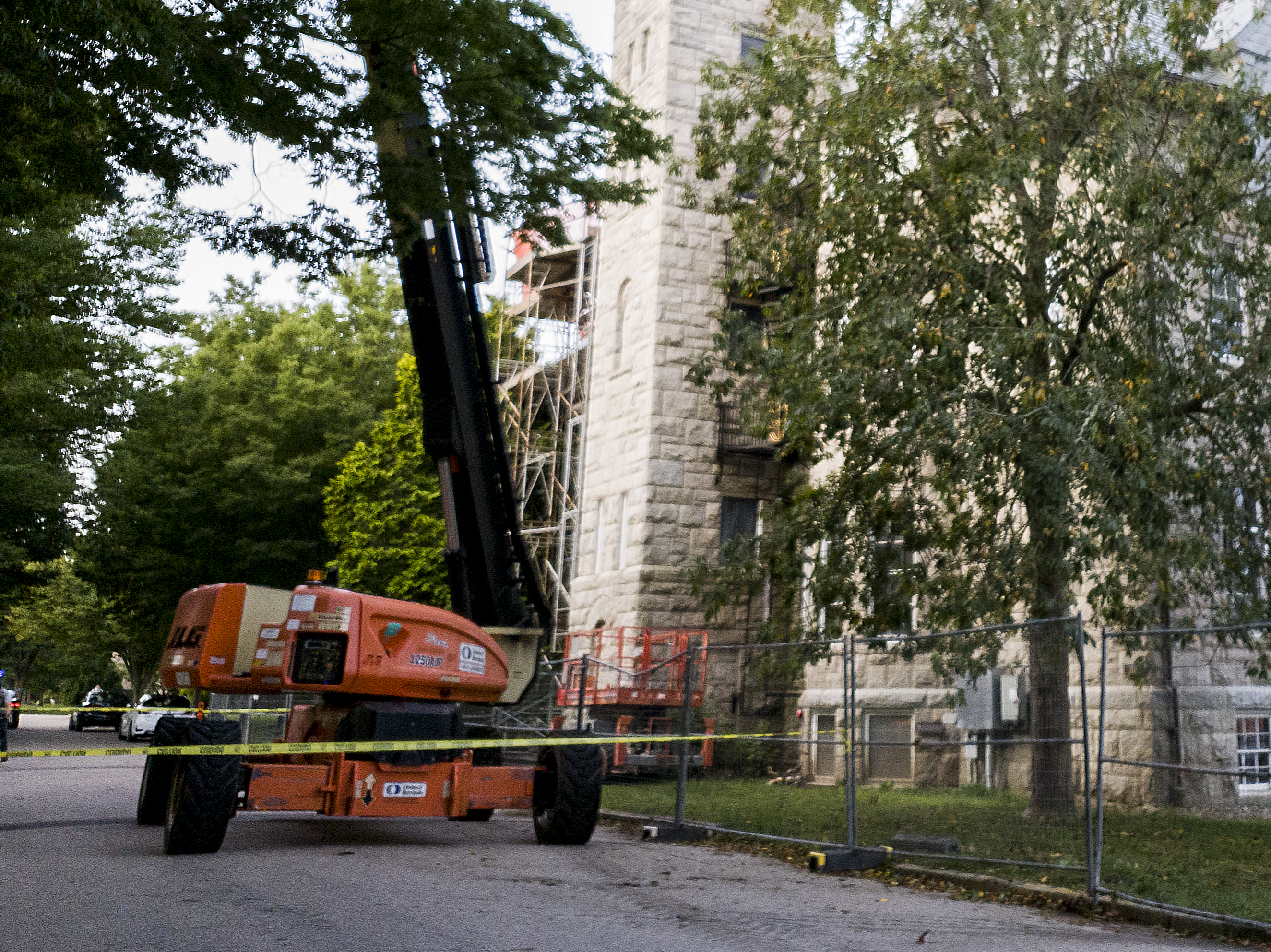A large cherry picker blocks the entrance and walkway for Davis Hall, where many students have class. Photo by Steven Lee.
During the summer, construction began on the historic Davis Hall to fix necessary roof damage and abate asbestos found in the ceiling.
Davis Hall is home to the Harrington School of Communication and Media, along with the majority of the Communication’s Department’s offices. Many faculty members were moved around because of the construction noise that came with the roof project, being placed into temporary offices in various buildings around campus.
While the roof project is the primary concern of the construction in Davis Hall, an issue of asbestos arose over the summer. A piece of ceiling fell in a faculty member’s vacant office on the third floor, which required immediate abatement of the office affected, along with two other neighboring rooms.
According to Assistant Director of Capital Projects Kenneth Burke, the ceiling damage they found on the third floor was directly related to the work that was happening above on the simultaneous roof project.
Once they found the asbestos-contaminated ceiling in the offices, the Office of Capital Projects blocked off the room, covered everything that could be affected, remove the furniture from the office, and from there took the ceiling down. The air quality has to pass tests before construction workers can enter the room again and rebuild the ceiling. As the ceiling is repaired, the occupant can move back into the office.
“We pushed to try to do the whole building before the start of the semester and there’s a series of steps that we had to get,” Burke said. “We worked with a moving company, we identified some alternative offices on campus, but even with us there was no way that we were going to be able to do all that abatement work, move people around and then move them back, before the start of the semester.”
Davis Hall still contains asbestos in the ceilings because the Office of Capital Projects didn’t have enough time to complete the construction over the summer. However, the asbestos is contained and safe for humans, according to Burke. Capital Projects is looking to strategically abate Davis Hall in its entirety over winter break or next summer.
“We felt comfortable that it was safe enough to move people back,” Burke said. “How do we know it’s safe? There’s a specific protocol. We hired a consultant to come out, they’ve got a machine, and they test the air quality. When asbestos is airborne, that’s when it’s a danger to humans.”
Chair of the Communications Department, Norbert Mundorf, whose office is located in Davis Hall, did not have his office evacuated, but had many of his colleagues temporarily evacuated from the building during the roof projects.
“The building is very old,” Mundorf said. “About 100 to 120 years old. The roof had to be redone and then in the process of doing the roof, some water came down into a couple of offices and damaged the ceiling and consequently they decided to clear out the offices on the upper floors and keep the occupants out. Fortunately it happened in summer.”
Some faculty members have been utilizing temporary advising locations in Ranger Hall, White Hall, and other buildings throughout campus. However, Mundorf did not believe that the relocation of faculty offices affected students.
“I think the students know,” Mundorf said. “They have announcements and the syllabus, they go onto Starfish and see it in Starfish. We see a lot of students coming in right now because now is the time to put in your intent to graduate. We are still seeing a lot of advising activity, either over in Ranger or in temporary locations.”
The construction is now wrapping up and the majority of the work has been completed. The scaffolding surrounding the building has been removed. However, the fencing has remained as a safety precaution. According to Burke, workers will continue to complete refacing on the outside of the building, but the work inside is in its final stages.
“It was a substantial roof project because of the historical nature of the building and the Quad,” Burke said. “It had to have that level of historical accuracy. That was the primary component of the project.”

